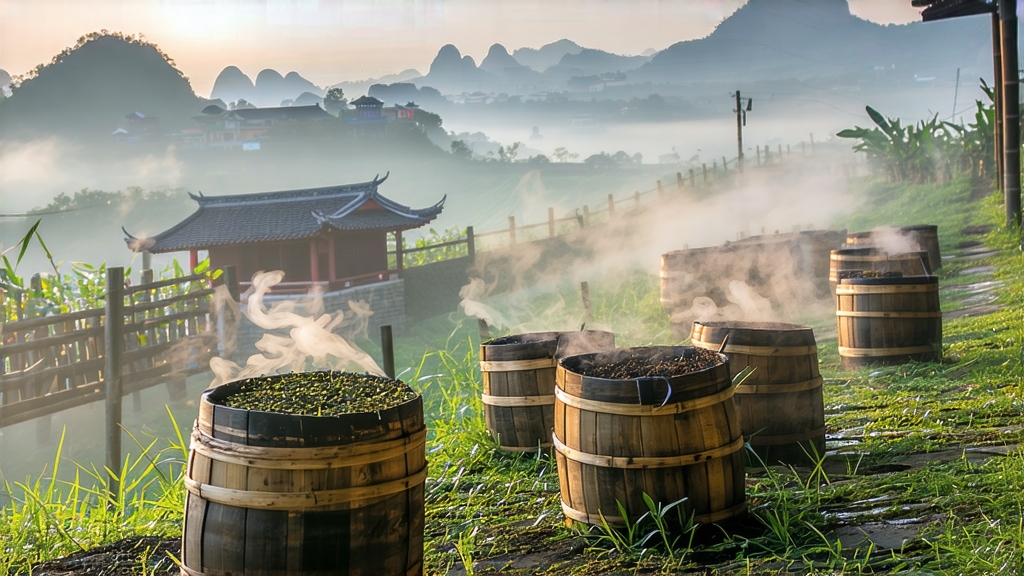
Tucked away in the humid, karst-pocked mountains of southern Guangxi, Liupao tea has spent four centuries quietly perfecting the art of microbial alchemy. To most outsiders the word “dark tea” conjures images of Yunnan’s Pu-erh, yet Liupao—older by half a century—remains the best-kept secret of China’s post-fermented family. Its leaves, coaxed by mountain mist and the spores of native Aspergillus, develop a flavor that Chinese connoisseurs liken to aged betel nut, camphor and wet autumn leaves, a profile so distinctive that it once fueled the thirst of dockworkers along the Pearl River and earned imperial tribute status during the Qing dynasty.
Historical footprints
The first written record appears in 1655, when a Guangdong merchant noted that “the Liu-pu people barter dark cakes for salt along the Xun River.” The name Liu-pu later morphed into Liupao, the township that still anchors production. By the 18th century the tea was compressed into 40-kilogram bamboo baskets, loaded onto bamboo rafts, and floated downriver to Guangzhou’s Thirteen Factories for export to Southeast Asia. There it became the breakfast staple of tin-mine laborers who believed the brew dispelled dampness and malaria. When the British blockaded the Pearl River during the Opium Wars, Liupao took the overland route—hence its nickname “tea horse road dark tea,” a southern echo of the more famous Yunnan-Tibet caravans.
Micro-terroir and leaf material
Liupao’s identity begins with a hyper-local cultivar called “Cangwu large-leaf,” a genetic cousin to Yunnan’s dayezhong but acclimated to Guangxi’s acidic red soils and subtropical monsoons. The bushes grow between 200–600 m on north-facing slopes where morning fog lingers until noon, slowing photosynthesis and concentrating amino acids. Farmers insist that the same leaf picked from the opposite slope will lack the signature “songxiang” (pine-resin note) because the microbial load drifting off the karst caves is different. Harvest window is narrow: only three spring flushes, each no longer than a carp’s ear, are deemed tender enough for top-grade Liupao.
Crafting the darkness
Unlike Pu-erh’s sun-fixation, Liupao undergoes a brief wok kill-green at 280 °C for exactly three minutes—long enough to denature polyphenol oxidase but short enough to preserve surface microbes. The leaves are then rolled twice, first light to crack cell walls, second heavy to squeeze out juice that will feed the coming fermentation. The critical step is “wet piling” (wo dui), yet here Guangxi diverges from Yunnan. Workers sprinkle river water drawn from the Xun’s granite bed, lower in minerals than Yunnan’s well water, creating a softer microbial canvas. The pile is covered with wild banana leaves rather than jute sacks; the leaves harbor Lactobacillus plantarum strains that suppress off-odors and generate a mellow lactic roundness. After 10–14 days the pile hits 55 °C, the thermal cue to turn. Masters judge readiness not by clock but by aroma: when the steam rising off the heap smells of dried longan and wet camphor bark, the pile is broken up and sun-dried on bamboo mats. A final 90-day basket aging follows, during which time the tea absorbs hints of bamboo tannin and river reeds.
Compression and time
Traditional Liupao is packed into cylindrical bamboo baskets lined with fresh banana leaf. The compression is loose enough that air can still circulate, allowing a slow secondary fermentation akin to breathing. A 1990s revival saw the creation of 100-gram mini-bricks for urban drinkers, yet purists still chase the “old basket” (lao luo) versions, claiming the bamboo’s lactones marry with the tea to produce a cooling aftertaste prized in Traditional Chinese Medicine for “clearing heat.” Properly stored baskets improve for decades; at 25 °C and 70 % humidity the tea enters a golden window after 15 years when its liquor turns translucent amber and the betel-nut note softens into dried fig and sandalwood.
How to brew Liupao like a Guangxi dockworker
The classic